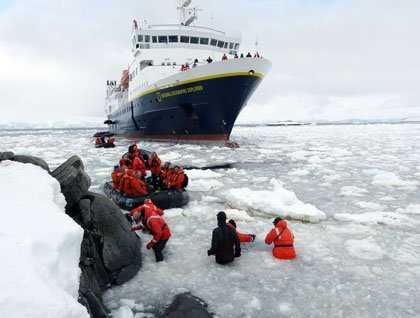The crew and staff aboard the National Geographic Explorer will do whatever it takes to provide our guests with the best possible Antarctic experience—witness our morning landing at Port Lockroy. This is the site of a former British base, occupied between 1944 and 1962. It was abandoned and falling into ruins until the U.K. Antarctic Heritage Trust stepped in to preserve this bit of Antarctic history. The refurbished buildings became an Antarctic museum and farthest South gift shop. We arrived this morning to find the bay packed with brash ice that had moved in with the wind and tide, but it was a visit not to be missed, especially with Christmas shopping at hand. Our ship pushed into the ice closer than we could ever imagine and the staff, led by Expedition Leader Lisa Kelley, donned chest waders and float coats to jump into the frigid water and push the ice aside, one Zodiac at a time, so we could land on the rocks below the base. The visit gave us a fascinating view into the lives of men (for they were all men) living in Antarctica in the mid-20th century.
We are fortunate to be travelling with killer whale biologists John Durban and Holly Fearnbach. Their research (supported in part by Lindblad Expeditions and the National Geographic Society) has shown that what we have called "killer whales" or "orca," Orcinus orca, actually consists of a number of forms that are distinct in morphology (size and coloration), behavior, and prey selection. The forms do not interbreed, and thus behave as distinct species; no doubt, they will soon be considered as such.
Early this afternoon we had an encounter with these black and white whales in Gerlache Strait. Instantly, the scheduled presentation in the lounge was set aside, we rushed to our favorite viewing spots and a Zodiac carrying John and Holly was quickly launched. These turned out to be the "large type B" killer whales. They travel in small groups, move quietly (that is, without vocalizing) and spend much of their time below the water surface, the better to sneak up on seals, their major prey. You can add "elusive" to their list of attributes, as they made changes in direction while hidden below the surface and the Zodiac was unable to approach closely.
But later, in Dallmann Bay, we had a second encounter with killer whales (what a productive day)! These turned out to be the "small type B" killer whales, and we could easily see how different these are from the previous. They are considerably smaller. They travel in much larger groups (there must have been 40 or so in the group, spread widely over the bay) and they are much more active at the surface. They eat smaller prey—penguins and fish—and as we came upon them, they were working together to corral penguins at the surface. John later explained how two whales cooperate to neatly strip the breast muscle from a penguin. Penguins are small, but there are lots of them and they are no match for a pack of hungry predators. This time the Zodiac was able to maneuver close to the whales and a dart was fired from a crossbow to fix a transmitter onto the tall dorsal fin of a male. We will be able to follow the movements of this whale (and the group of which it is a member) for the next three to four months. Search "Antarctic killer whale tracking" to find the website with information, updated daily, on what we can now regard as OUR whale in Antarctica.









